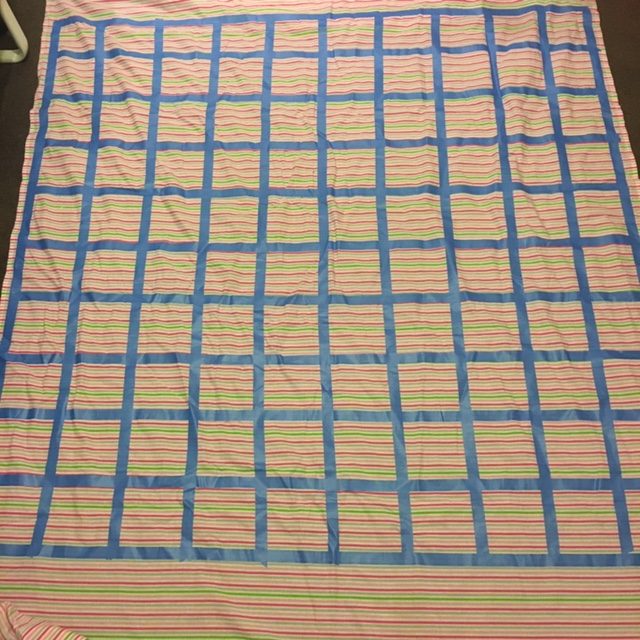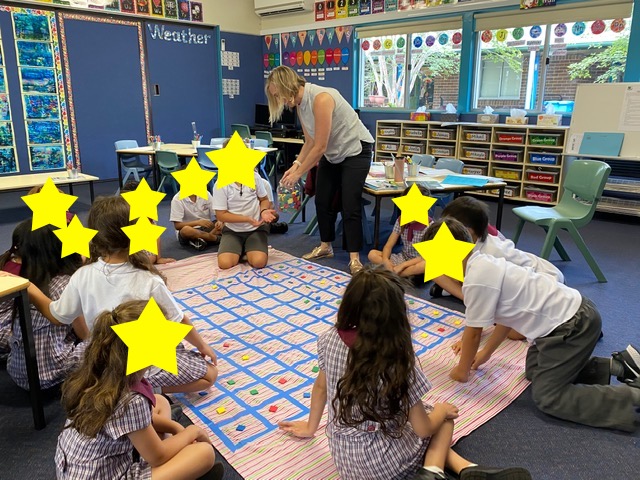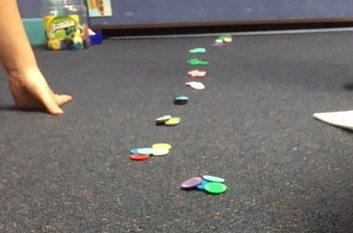I was inspired a few weeks ago by a Twitter post I found that Mrs. Unsworth’s (@MrsUnsworthWTT) had previously shared about using a concrete hundreds chart to visualise skip counting. I really loved the way the students moved across the mat to show how they were counting. I thought this was an excellent way to show what efficient counting looks and sounds like and also a good opportunity to show the difference purposes between strategies.
Good reasons to use a concrete hundreds chart:
- the size of 100 as a quantity is clear
- the row structure of 10s can be created with objects
- no numbers, so counting and check counting are required
- connections are made between quantity, visual, objects, and movement
- it’s large, so all students can see the chart
- students can notice other students’ strategies
- consolidation of matching the number words with the count to large numbers
- gaps in understanding about what a hundreds chart is can be discussed
- students love placing and removing the objects
- time can be allowed for playing with numbers and trying out strategies
- non-permanent, so students can make further attempts
- can be adapted for area, addition, length, patterns, shape
A6: Oh! I like doing this large Counting Collections as a whole class as a followup too. It is a nice visual for skip counting. I find hundreds charts to be vague for some students and this creates a physical representation of how it works. #elemmathchat https://t.co/PyBzXhjWW0
— Mrs. Unsworth (@MrsUnsworthWTT) October 30, 2020
I must say, I didn’t have access to the beautifully commercially made carpet Mrs Unsworth had! I created my hundreds chart from an old sheet and painter’s tape. I used foam tiles for the objects but you could use anything. I was lucky enough to be teaching a demonstration lesson in a local primary school with two Year 2 classes and I thought the skip counting task would assist students in visualising the count. I used the concrete hundreds chart as a lesson launch that focused on ways of skip counting.
Talking about how many?
I started by showing them the sheet on the floor and asking how many spaces were there? In both classes they were confident it was 100. Most linked my visual to the hundreds chart they had used in the past or said they counted along the top row, noticed it was 10, then counted by 10s to check it was 100. This was a great start but what does skip counting sound like? and what does it look like? I asked students to help me place 100 tiles on the hundreds chart, one on each square.
What does counting look and sound like?
Once we had the hundreds chart covered with tiles, I asked the students how could we count them? Students provided excellent ideas such as by ones, by twos, by fives, and by tens. By tens was mentioned first so I asked one student to show me what that looks like. Similar to Mrs Unsworth, I had another student with a bottom-up hundreds chart highlighting the numbers during the count. It’s important at this stage to stop talking as the teacher (Roche and Clarke have written a great article about holding back from telling).
We can sometimes fall into the trap of over-helping and providing assistance, hints, or scaffolds before they are even needed. I had already predicted that the student would at some point have too many tiles in his hands to keep picking up more tiles. I wanted this problem to arise so that he, and other students, could see the need for grouping parts of the count. The need for grouping (in this case placing the tiles in piles) isn’t something students always connect to why we count in multiples or group items.
As he continued counting, he realised he needed to put down some of the counters (this issue arose in both classes). I asked the class for suggestions of what to do with the tiles. Some said one big pile, I prompted “how will we know how many we have counted?” Then someone added piles of ten, another eagle-eyed students spotted my coloured cups and suggested we use those. Students in one class also suggested putting the cups at the end of each row to know where each ten was.
Continuing the counting conversation
The students took turns to helping to finish the count. We noticed the student who was highlighting the numbers ‘raced ahead’ with the colouring, this gave rise to a nice talk about multiples and the patterns they make on the written hundreds chart. I asked students to count with the student and recount at the end by tens. We then discussed other counts, e.g. by twos and fives. Students took turns with a smaller number of tiles out on the chart (20-30) to show what that would look and sound like. It was nice to see students make the connection between fives and tens, stating that we’d need more cups and that they would go half-way along each row. It was good that students realised that counting by tens with objects involves two counts – one by ones, then by tens. Another good discussion happened then about counting by twos being ‘quicker’ with a small number of items but that it might not be as helpful when counting larger collections.
Extending the conversation – exploring counting large collections
Students then worked in pairs or small groups to count large collections of items (Choral counting and counting large collections by Franke, Kazemi and Turrou has influenced much of my early years lessons). Many chose to count in groups of fives or tens, some tried threes and some tried twos. A few groups discovered the benefit of ‘lining up’ rows of what they counted to make the counting of groups easier later on. Overall it was lovely to see students engaged in counting tasks to build skip counting strategies and to be able to share reasons for their strategies.
Summarising the learning
To summarise the lesson, students were asked to record their strategy for counting and write the numbers they said as they counted. Some students also found the total and knew to keep the remainders separate from the equal groups. Thanks to Mrs Unsworth for the great lesson idea!












